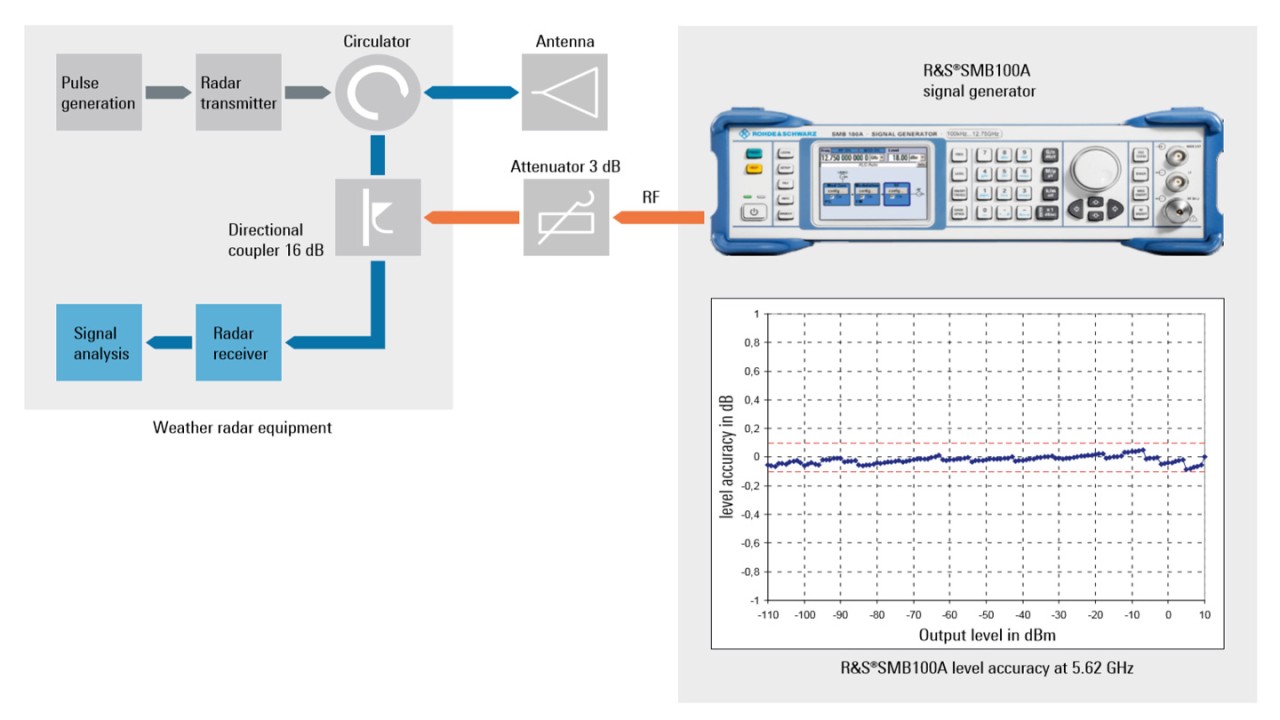Calibrate your weather radar receivers using the R&S®SMB100A
The R&S®SMB100A analog signal generator is the ideal calibration source for weather radar receivers due to its highly accurate output level.

The R&S®SMB100A analog signal generator is the ideal calibration source for weather radar receivers due to its highly accurate output level.
Meteorologists use weather radar equipment primarily to analyze the dynamic structure of individual clouds or cloud systems, and for exhaustive, continuous precipitation measurement. An important parameter for exact weather forecasts is the precipitation intensity or rain rate that is measured by weather radars.
Although radar equipment cannot measure precipitation intensity directly, it can measure reflectivity. Reflectivity is a unit for the backscattering cross section of targets and is proportional to the energy that is backscattered from all scattering particles in the radar beam to the antenna. The greater the number and size of raindrops in the air, the higher the reflectivity.
The quantitative determination of reflectivity is basically a two-port measurement with the radar transmitter as the signal source and the receiver as the selective power meter. The transmission factor of the path from transmitter to receiver can be calculated from the known transmitted power (Pt) and the measured received power (Pr). This transmission factor includes the target reflectivity, the antenna gain and the attenuation factor of the path from the antenna to the radar target. Since the antenna gain and the transmission loss are known, the reflectivity can be calculated.
Radar transmitters usually generate sufficiently accurate output power to determine reflectivity. With receivers, this is more difficult. In general, they are able to monitor level changes with high accuracy, but they are characteristically too inaccurate for measuring absolute levels.
The accuracy necessary for this measurement can be achieved by regularly calibrating these receivers with a signal source that has a highly accurate output level. Calibrated weather radar equipment is indispensable for precisely determining the precipitation probability as well as the density of rain, snow or fog.
The R&S®SMB100A analog signal generator provides very precise output levels for calibrating weather radar receivers.
For calibration, the R&S®SMB100A is looped-in using a directional coupler (16 dB coupler) in the receive line of the weather radar.
A 3 dB attenuator should be inserted between the coupling port of the directional coupler and the R&S®SMB100A to improve impedance matching. The total attenuation from the R&S®SMB100A output to the radar receiver input must be known so that it can be taken into account when setting the level of the R&S®SMB100A. This attenuation, which is precisely measured during installation, is almost exactly 20 dB – a result of transmission loss of the directional coupler, the attenuator and cable losses. The level of the R&S®SMB100A is therefore varied from +10 dBm to –90 dBm to cover the range of –10 dBm to –110 dBm, which is optimal for most radar receivers.
During receiver calibration, the radar transmitter is switched off and the R&S®SMB100A generates the calibration signal at the required frequency and level. The signal level measured by the receiver is read and compared with the calibration level to calculate a correction value. Since the receivers typically exhibit good relative level accuracy, it is sufficient to perform a two-point calibration where the correction values for the receiver are calculated and saved for a high level, e.g. –10 dBm, and a low level, e.g. –70 dBm.
If required, more than two calibration points can be used. Even the lower sensitivity limit of the receiver, e.g. –110 dBm, can be reached with the R&S®SMB100A. After calibration, the R&S®SMB100A is switched off and the radar equipment is ready for regular operation. The calibration intervals depend on the receiver’s stability and are usually one month.
The R&S®SMB100A offers a measured level accuracy of < 0.1 dB (at 5.62 GHz and room temperature) for the relevant output levels. Moreover, its maximum output frequency of 12.75 GHz enables calibration up to the X frequency band. The R&S®SMB100A is thus the ideal, high-accuracy source for calibrating the absolute level measurement of weather radar receivers.
For even higher performance requirements, the high-end analog signal generator R&S®SMA100A, which provides excellent spectral purity, can be used.

